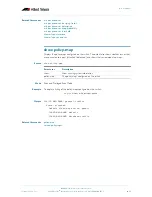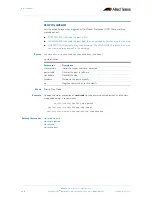
802.1x Configuration
©2008 Allied Telesis Inc. All rights reserved.
41.2
AlliedWare Plus
TM
Operating System Software Reference C613-50003-00 REV E
Software Version 5.2.1
Introduction
The IEEE Standard 802.1x provides a method of restricting access to networks based on
authentication information. 802.1x provides port-based network access control for devices
connected to the Ethernet. This allows a network controller to restrict external devices from
gaining access to the network behind an 802.1x controlled port. External devices that wish to
access services via a port under 802.1x control must firstly authenticate themselves and gain
authorization before any packets originating from, or destined for, the external device are
allowed to pass through the 802.1x controlled port.
The 802.1x Implementation
802.1x port access control is achieved by making devices attached to a controlled port
authenticate themselves via communication with an authentication server before these devices
are allowed to access the network behind the controlled port.
Authentication is required on a per-port basis. The main components of an 802.1x
implementation are:
■
the authenticator - the port on this device that wishes to enforce authentication before
allowing access to services that are accessible behind it.
■
the supplicant - the port that wishes to access services offered by the authenticator’s
system. The supplicant may be a port on a PC or other device connected to this device.
■
the authentication server - a device that uses the authentication credentials supplied by the
supplicant, via the authenticator, to determine if the authenticator should grant access to
its services.
Configuring 802.1x
The following example explains how to configure 802.1x on Allied Telesis managed Layer 3
Switches.
In this example, the Radius Server keeps the Client information, validating the identity of the
Client and updating the switch about the authentication status of the client. The switch is the
physical access between the two clients and the server. It requests information from the client,
relays information to the server and then back to the client.
To configure 802.1x authentication, first enable authentication on port1.0.1 and port1.0.2 and
then specify the Radius Server IP address and port.
















































